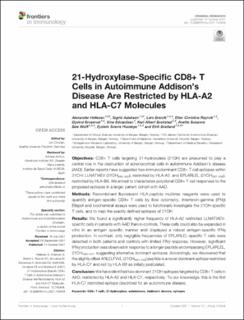| dc.contributor.author | Hellesen, Alexander | |
| dc.contributor.author | Aslaksen, Sigrid | |
| dc.contributor.author | Breivik, Lars Ertesvåg | |
| dc.contributor.author | Røyrvik, Ellen Christine | |
| dc.contributor.author | Bruserud, Øyvind | |
| dc.contributor.author | Edvardsen, Kine Susann Waade | |
| dc.contributor.author | Brokstad, Karl Albert | |
| dc.contributor.author | Wolff, Anette Susanne Bøe | |
| dc.contributor.author | Husebye, Eystein Sverre | |
| dc.contributor.author | Bratland, Eirik | |
| dc.date.accessioned | 2022-02-02T13:40:22Z | |
| dc.date.available | 2022-02-02T13:40:22Z | |
| dc.date.created | 2021-11-10T16:04:58Z | |
| dc.date.issued | 2021 | |
| dc.identifier.issn | 1664-3224 | |
| dc.identifier.uri | https://hdl.handle.net/11250/2976688 | |
| dc.description.abstract | Objectives: CD8+ T cells targeting 21-hydroxylase (21OH) are presumed to play a central role in the destruction of adrenocortical cells in autoimmune Addison’s disease (AAD). Earlier reports have suggested two immunodominant CD8+ T cell epitopes within 21OH: LLNATIAEV (21OH342-350), restricted by HLA-A2, and EPLARLEL (21OH431-438), restricted by HLA-B8. We aimed to characterize polyclonal CD8+ T cell responses to the proposed epitopes in a larger patient cohort with AAD.
Methods: Recombinant fluorescent HLA-peptide multimer reagents were used to quantify antigen-specific CD8+ T cells by flow cytometry. Interferon-gamma (IFNγ) Elispot and biochemical assays were used to functionally investigate the 21OH-specific T cells, and to map the exactly defined epitopes of 21OH.
Results: We found a significantly higher frequency of HLA-A2 restricted LLNATIAEV-specific cells in patients with AAD than in controls. These cells could also be expanded in vitro in an antigen specific manner and displayed a robust antigen-specific IFNγ production. In contrast, only negligible frequencies of EPLARLEL-specific T cells were detected in both patients and controls with limited IFNγ response. However, significant IFNγ production was observed in response to a longer peptide encompassing EPLARLEL, 21OH430-447, suggesting alternative dominant epitopes. Accordingly, we discovered that the slightly offset ARLELFVVL (21OH434-442) peptide is a novel dominant epitope restricted by HLA-C7 and not by HLA-B8 as initially postulated.
Conclusion: We have identified two dominant 21OH epitopes targeted by CD8+ T cells in AAD, restricted by HLA-A2 and HLA-C7, respectively. To our knowledge, this is the first HLA-C7 restricted epitope described for an autoimmune disease. | en_US |
| dc.language.iso | eng | en_US |
| dc.publisher | Frontiers Media | en_US |
| dc.rights | Navngivelse 4.0 Internasjonal | * |
| dc.rights.uri | http://creativecommons.org/licenses/by/4.0/deed.no | * |
| dc.title | 21-Hydroxylase-Specific CD8+ T Cells in Autoimmune Addison’s Disease Are Restricted by HLA-A2 and HLA-C7 Molecules | en_US |
| dc.type | Journal article | en_US |
| dc.type | Peer reviewed | en_US |
| dc.description.version | publishedVersion | en_US |
| dc.rights.holder | Copyright 2021 Hellesen, Aslaksen, Breivik, Røyrvik, Bruserud, Edvardsen, Brokstad, Wolff, Husebye and Bratland | en_US |
| dc.source.articlenumber | 742848 | en_US |
| cristin.ispublished | true | |
| cristin.fulltext | original | |
| cristin.qualitycode | 1 | |
| dc.identifier.doi | 10.3389/fimmu.2021.742848 | |
| dc.identifier.cristin | 1953331 | |
| dc.source.journal | Frontiers in Immunology | en_US |
| dc.relation.project | Norges forskningsråd: 262677 | en_US |
| dc.identifier.citation | Frontiers in Immunology. 2021, 12, 742848. | en_US |
| dc.source.volume | 12 | en_US |

